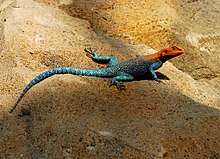Agama agama
The common agama, red-headed rock agama, or rainbow agama (Agama agama) is a species of lizard from the family Agamidae found in most of sub-Saharan Africa. To clear up historical confusion based on Linnaeus and other authors, Wagner, et al. (2009) [1] designated a neotype (ZFMK 15222) for the species, using a previously described specimen from Cameroon in the collection of the Zoologisches Forschungsmuseum Alexander Koenig in Bonn. The species name was formerly applied to a paraphyletic collection of taxa, and mitochondrial DNA analysis of various populations indicates they represent separate species.[2],[3] Consequently, three former subspecies A. a. africana, A. a. boensis, and A. a. mucosoensis are now considered separate species, and A. a. savattieri is considered synonymous with A. africana.[4]
| Agama agama | |
|---|---|
 | |
| Male | |
_female_2.jpg) | |
| Female both in Kakum National Park, Ghana | |
| Scientific classification | |
| Kingdom: | Animalia |
| Phylum: | Chordata |
| Class: | Reptilia |
| Order: | Squamata |
| Suborder: | Iguania |
| Family: | Agamidae |
| Genus: | Agama |
| Species: | A. agama |
| Binomial name | |
| Agama agama | |
Description
Its size varies from 13 to 30 cm (5.1 to 11.8 in) in total length.[5] Males are typically 7.5–12.5 cm (3–5 inches) longer than the average female. The agama lizard can be identified by having a white underside, brown back limbs and a tail with a light stripe down the middle. The stripe on the tail typically possesses about six to seven dark patches along its side. Females, adolescents and subordinate males have an olive green head, while a dominant male have a blue body and yellow tail.
Distribution and habitat
The common agama can be found native in countries such as Benin, Burkina Faso, Cameroon, Cabo Verde, Chad, Gabon, Ghana, Guinea, Guinea-Bissau, Kenya, Liberia, Mali, Mauritania, Nigeria, Senegal, Togo, and Madagascar.[6],.[7] However, it has been introduced through the reptile trade to southern Florida, where it has become extremely common. Agama agama is well-suited to arid conditions. These lizards remain active throughout the day except for the hottest hour, when even shady spots can reach 38 °C (100 °F).[8]
Diet
Common agamas are primarily insectivores, but they have been known to eat small mammals, reptiles and vegetation. They catch their prey using their tongue, the tip of which is covered by mucous glands that enable the lizard to hold to smaller prey.[9]
Behavior
Male agamas are territorial and must fight other males to claim their space. Agamas live in social groups including a lead male, about half a dozen females, and subordinate males. Subordinate males can only gain their own group if they eliminate the existing lead male (the "cock") or establish a colony outside all other cocks' territory. Only the cock is allowed to mate with the females. The center of a cock's territory is usually marked by the presence of a physical object, such as a tree or boulder, on which the lizards congregate. In urban areas, fights between males are more common because space is at a higher premium.[10]
Reproduction
Females are sexually matured at 14–18 months, while males take 2 years. Agama agama tends to reproduce during the wet season, but can also reproduce in areas that receive constant rainfall. After fertilization and when she is ready, the female will dig a hole 5 cm deep with her snout and claws in sandy, wet/damp soil that is covered with grasses or other plants and which receives sunlight during most of the day. Once finished, the female will lay a clutch of five to seven ellipsoidal eggs that hatch within a period of 8–10 weeks. Common agama has thermoregulated embryos, so all male eggs will have a temperature of 29 °C, while female eggs will be in the range 26–27 °C. After hatching, the offspring will measure 3.7–3.8 cm snout–vent, plus their 7.5-cm tail.[11]
_male.jpg) male, Kenya
male, Kenya_female.jpg) female, Kenya
female, Kenya_female_moulting.jpg) female moulting, Gambia
female moulting, Gambia.jpg) Zoo Schmiding near Bad Schallerbach, Austria
Zoo Schmiding near Bad Schallerbach, Austria
References
- Wagner, Philipp; Wilms, Thomas M.; Bauer, Aaron; Böhme, Wolfgang (2009). "Studies on African Agama. V. On the origin of Lacerta agama Linnaeus, 1758 (Squamata: Agamidae)" (PDF). Bonner zoologische Beiträge. 56: 215–223.
- Leaché, A.D. et al. (2009). Phylogeny of the genus Agama based on mitochondrial DNA sequence data. Bonner zoologische Beiträge 56(4) 273-78.
- Mediannikov, O., Trape, S. and Trape, J-F. (2012). A Molecular Study of the Genus Agama (Squamata: Agamidae) in West Africa, with Description of Two New Species and a Review of the Taxonomy, Geographic Distribution, and Ecology of Currently Recognized Species. Russian Journal of Herpetology 19(2).
- Agama, The Reptile Database
- Burton, Maurice and Robert Burton. (2002). International Wildlife Encyclopedia, 3rd edition. New York: Marshall Cavendish Corp. p.30.
- "Figure 1. Agama agama from Antananarivo Airport (Madagascar). Photo by..." ResearchGate. Retrieved 2018-09-04.
- "Agama agama". The Reptile Database. Retrieved 2017-04-27.
- "The Habitat of the Agama Lizard". Retrieved 2017-05-02.
- "Agama agama (Common Agama, Rainbow Lizard)". Animal Diversity Web. Retrieved 2017-05-02.
- "The Habitat of the Agama Lizard". Retrieved 2017-05-02.
- "Agama agama (Common Agama, Rainbow Lizard)". Animal Diversity Web. Retrieved 2017-05-02.
Further reading
- Spawls, S., et al. (2006). Reptiles and Amphibians of East Africa Princeton: Princeton University Press.
External links
- Agama agama at the Reptarium.cz Reptile Database
- "Agama agama". Integrated Taxonomic Information System.

